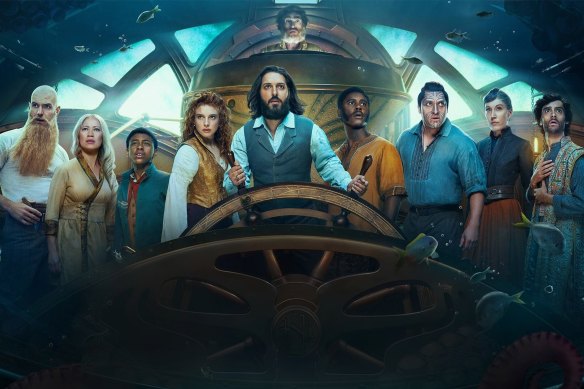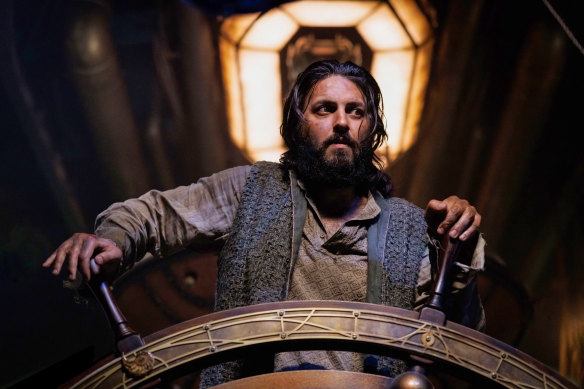- Exclusive
- Culture
- TV & radio
- Streaming
This was published 10 months ago
How a $300 million TV show almost sank without trace
By Karl Quinn
A year after it was scuppered by Disney, the $300 million submarine series Nautilus is about to resurface on Australian streamer Stan.
The 10-part adventure drama, loosely based on Jules Verne’s 1870 novel Twenty Thousand Leagues Under the Seas*, was shot on the Gold Coast, and its overall budget makes it the most expensive TV series made in Australia.

Shazad Latif (centre) as Captain Nemo in Nautilus, which was filmed at the Village Roadshow Studios on the Gold Coast. Credit: Stan
Originally commissioned for Disney+, the show was sunk last August by Bob Iger shortly after his return to the chief executive role as part of “aggressive cost reductions” that aimed to take $US5.5 billion out of the business. Up to $US1.8 billion of that came from axing or shelving content that had been destined for its streaming platforms, including Disney+, Hulu and Star.
Producer Xavier Marchand says the news that Nautilus would not go to Disney+ after all “was crushing”, especially given the long connection between Captain Nemo and the studio – which made the 20,000 Leagues movie in 1954, starring James Mason.
“When we pitched the project to Disney they were super enthusiastic, they said, ‘we love your take’,” says Marchand. “We’ve since learned that people pitch Nemo stories every other week to Disney, so we were very blessed to have been chosen and to make the show for what we felt was its natural home.”
Indeed, Disney had planned to shoot a film of Twenty Thousand Leagues on the Gold Coast – with David Fincher (Se7en, The Social Network) directing and Brad Pitt as Nemo – as far back as 2013. But that project, unrelated to this one, sank without trace.

Though Nemo first appeared in Jules Verne’s Twenty Thousand Leagues Under the Sea, the series is equally indebted to the sequel, Mysterious Island. Credit: Vince Valitutti/Disney+
“We still don’t really understand what happened,” Marchand says of the studio’s decision to dump his show last year. “But it is what it is. And now we’re super-excited that Stan picked it up. There’s a silver lining to it in some ways.”
The Australian streamer, which is owned (like this masthead) by Nine, has not yet revealed an air date beyond “coming soon”. But it is also a natural home of sorts for the show, given its Australian connections.
The series was filmed in Queensland from February to December 2022, employing at its peak 550 cast and crew and occupying three sound stages at Village Roadshow Studios.
“I would say 80 per cent of the people employed were Queenslanders, most of the cast was Australian,” says Marchand. “The great thing about Queensland is it gives you so many worlds. The show takes you from India and journeys across the oceans of the world up through the frozen Arctic and down into England. Each episode is a different universe.”

Verne originally wanted his Nemo to be Polish, but in the 1874 sequel he cast him as an Indian prince at war with British colonialism.Credit: Stan
Though the overall budget was massive, Marchand insists “the cost per minute we did very, very well, because it was like making 10 little mini-movies, all with an entirely new world. The money is on the screen.”
Naturally, much of the story is set aboard the Nautilus, the submarine aboard which Nemo and his crew sail the seas, encountering giant aquatic creatures and running afoul of navies and pirates. But that’s where this story and the Nemo of the earlier film version part ways.
Nemo first appeared in 1869, in fortnightly instalments published in a French magazine and issued in novel form the following year. Though Frenchman Verne had originally considered his hero to be Polish, his publisher convinced him to leave his hero’s origins murky.
But in the follow-up novel Mysterious Island (1874), Verne had Nemo deliver a deathbed confession in which he revealed he was in fact an Indian prince named Dakkar, who bore a hatred of British imperialism and led an uprising against colonial rule in Sepoy (a reference to the real-life Indian rebellion of 1857).
“He was wounded 10 times in 20 battles,” Verne wrote, “and was unable to find death when the last soldiers of independence fell before the English guns.”
This is the Nemo of Nautilus, a high-born Indian anti-colonialist adventurer, played by Shazad Latif.
The seed of the idea came from writer Mark Stay, whose pitch Marchand optioned in 2020, but it was writer James Dormer – a former British diplomat who had been based in Delhi, whose mother was born in Hyderabad, and whose kids are half-Bengali – who brought it to life.
It is, he says, an anti-colonial tale with sea monsters. But it was important to ensure his “bad guys” always remained human.
“The thing was always to keep hold of both sides of the story, so that it’s balanced, so you’re not just hitting people over the head with the message,” says Dormer. “People are complicated, and what we’ve tried to do with all the characters, even the bad guys, is give them a reason for doing what they’re doing, so you understand them.”
*NOTE: While the many screen adaptations have used the title 20,000 Leagues Under the Sea, Verne’s novel was originally published as Vingt Mille Lieues sous les mers (Twenty Thousand Leagues Under the Seas, plural).